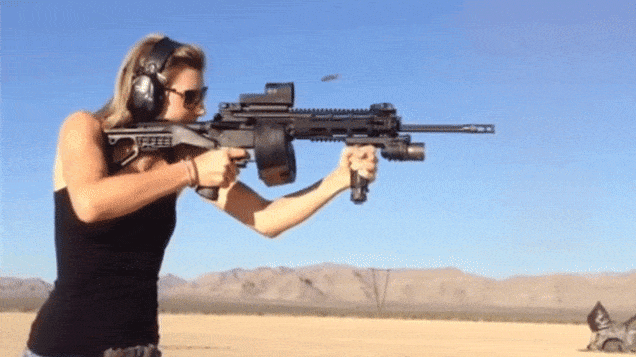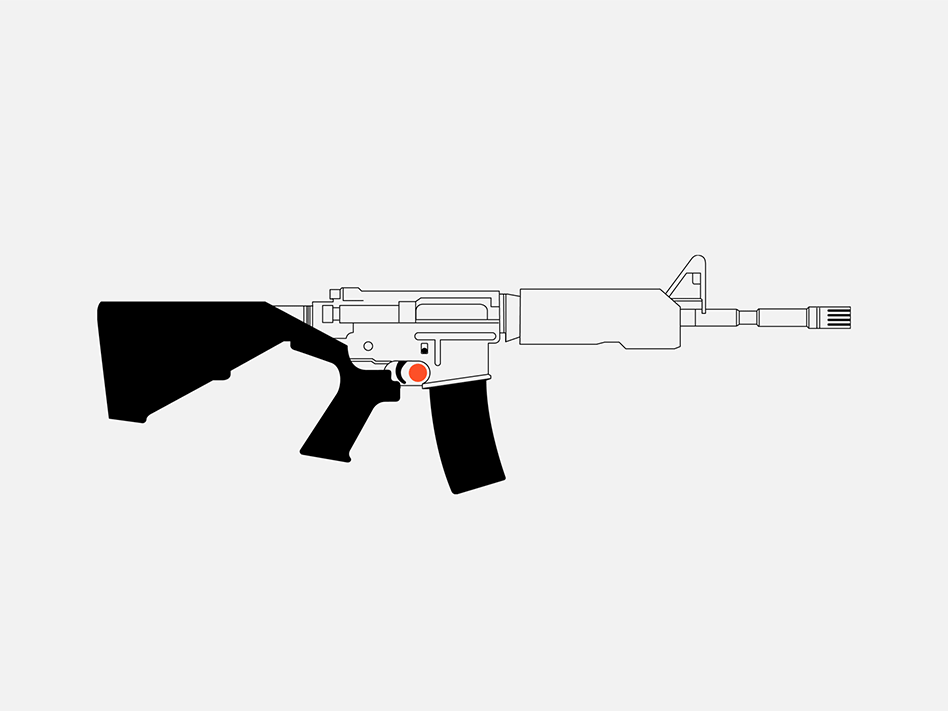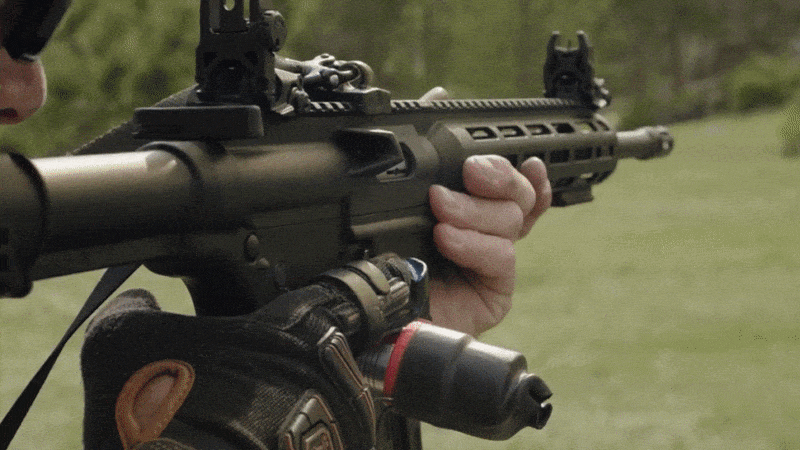
"What are you waiting for? With a bump stock, it's easy for anyone to simulate a machine gun!" [o]
Visitor: Repeatedly I’ve heard that “our thoughts and prayers are with the families.” Of course they are, but the question is why the concert-goers became victims.
Me: Yes, well, defenders of gun rights point out that a semi-automatic rifle would have done less harm, but the shooter’s guns were modified with a “bump stock,” which enabled him to fire as if they were automatics.
Visitor: It would have been okay if he fired at the slower semi-automatic rate?
Me: Of course not. It wouldn’t have been acceptable if he’d fired just a single shot into the crowd. He was crazy.
Visitor: Given that a small minority of the populace is crazy, and your frontier is long gone, why do you still have a gun culture?
Me: Our Constitution has a second amendment about firearms.
Visitor: Which says what?
Me: Wait, it was in the paper. “A well regulated Militia, being necessary to the security of a free State…”
How does it feel to live in a country where the extreme gun culture is a thing of the past?
Visitor: So the amendment is about the necessity of a militia, which is well regulated?
Me: Wait, there’s more: “the right of the people to keep and bear Arms, shall not be infringed.”
Visitor: To bear arms in a well-regulated militia?
Me: Well, that’s not what the Supreme Court decided. They said it’s the right of an individual, for lawful purposes, such as hunting deer, shooting at a range, repelling a domestic intruder.”
Visitor: Let’s google it.
Me: Here it is a case in 2008. Wait, it’s long, the decision is 64 pages.
Visitor: I’m curious to see how they managed to find an individual right, but we can’t read the decision now.
Me: There’s also a dissent or two.
Visitor: I’m not surprised.
Me: Neither of us is a lawyer, but let’s read the decision a soon as we can and discuss it before you leave. Now I’m curious: you said you have a vision. What is it?
Visitor: Australia also had a massacre, at a place called Port Arthur. Thirty-five people were killed there in 1996, others injured. In my country guns are regulated not at the federal level but in each province. In response to the massacre, the prime minister, the national leader, asked each province to adopt the same policy toward the gun culture. The government offered to buy automatic, semi-automatic, and certain other weapons, and made possession after a certain date illegal. Guns turned in were paid for, then destroyed. Not all relevant guns were brought in, but any hidden away became illegal. Much of the gun culture was delegitimated.
Me: So how does it feel to live in a country where the extreme gun culture is a thing of the past?
Visitor: The change came when I was young, so it feels normal. We haven’t had a mass shooting in Australia after Port Arthur. Of course one is possible, but it hasn’t happened. What I notice is not anything unusual at home, but the massacres that occur in the U.S. That, and the whole culture of guns here.
Me: So you are focused not only on the physical existence of firearms but also on the culture surrounding them.

Twelve of the Las Vegas shooter's rifles were outfitted with “bump stock” devices — inexpensive accessories that enable semiautomatic firearms to mimic automatic gunfire. [o]
Visitor: Let me ask you about your own experience of the gun culture while growing up here.
Me: Regarding our attitude toward guns I was raised to regard them as normal. As a child I lay on the living room floor before dinner listening to the Lone Ranger: “Return with us now to those thrilling days of yesteryear, when from out of the past come the thundering hoof-beats of the great horse Silver! The Lone Ranger rides again!”
Visitor: I’ve heard of the masked man and his Indian sidekick.
Me: My Dad didn’t pass along a rifle and wasn’t the one to teach me gun safety. (I learned that at Boy Scout camp.) But Dad’s ancestors in the Mid-west kept guns to kill “varmints” on their farms. Let’s see, two of my uncles were police officers. And of course earlier we had the frontier.
Visitor: We Australians had a wild west, too. But not anymore.
Me: My brother and I grew up on John Wayne and other cowboy movies. In Boy Scout camp I was not bad on the shooting range and saved shot-out bull’s eyes to prove it.
Visitor: You’re proud of blasting the center of the target?
Me: Damn right. But, as it happened, I left all that behind me in adolescence. I understand people who like to shoot on ranges, and to hunt deer. On a ranch where I lived during grad school, the owners left a shotgun with me to use against rattlesnakes, if any became ornery. The father of my former wife liked to shoot at clay disks launched into the sky.
The first row of icons fills a little more than one line, the second requires scrolling down, and further down, and still further. What kind of system is this?
Visitor: Sounds as if you had an initiation into the U.S. gun culture. Which was not so different from Australian gun culture of my Dad’s generation.
Me: Well, I was never a member of the National Rifle Association and, apart from that shotgun on the ranch, never kept a firearm in the house
Visitor: What about human intruders? Self-defense?
Me: I’ve never had an intruder., in spit of living in Manhattan, in suburbs, and in the country. They exist, but how does that possibility compare with the number of mass shootings?
Visitor: In Australia we have a comedian who talks about the scenario of being woken up in the middle of the night in the U.S. and having to open the gun safe where you safely store your weapon to prevent accidents caused by a child. “Wait a minute, please…”
Me: I guess if an intruder thought you were going to fire at him, he’d be anxious to shoot you before you can hit him.
Visitor: Both of our countries value liberty, but liberty doesn’t mean each person can do whatever he wants, if that activity supports a gun culture in which crazy people get access to weapons after being raised on images of violence. How is it liberty if you are shot in a concert, or a nightclub, or a movie theater, or school. Are the victims “free”?

Some hope . . . The AutoGlove billed itself as a mechanism that allows for “full-auto fire without ATF approval, tax stamp or firearm modifications.” On September 16, 2017, the Bureau of Alcohol, Tobacco, Firearms and Explosives (ATF) determined "the AutoGlove may not be used or possessed by individuals." [o]
Later I got together again with my visiting friend. We’d both gone online to read the decision in the relevant Supreme Court case. Here is what we said:
Visitor: What I was struck by, before getting to the arguments in this 5-4 decision, was the tone of contempt toward the dissent filed by Justice Stevens. My attention to this tone was caught initially by the charge that Stevens was “dead wrong” about something. Then, that Stevens “resorts to a bizarre argument,” that an assertion of Stevens is “wholly unsupported” on another point that Stevens “has brought forward absolutely no evidence,” and that “nothing so clearly demonstrates the weakness” of Stevens’ case.
Me: I don’t’ know whether calling a fellow Justice “dead wrong,” especially in a gun case, is par for the course in Supreme Court decisions, and whether writing that his arguments are weak, bizarre, wholly unsupported is customary. But what about the arguments in the decision?
Visitor: I’m not a legal scholar, but the argument seems to turn on a distinction that Justice Scalia makes very early, identifying one half of the second amendment as “operative” and the other, the very first half, as merely “prefatory,” as if it did not provide the context in which the second half must be understood. Making this distinction pre-judges the whole case, which turns on the correct interpretation of the amendment. How can the first half of the amendment reasonably be treated as an irrelevance, or merely as one possible use of the guns that anyone can keep and carry?
Me: Being from another country you may not know about how well, organized gun owners are in the U.S., how pervasive is the gun culture, how threatened many politicians would feel about being targeted by the National Rifle Association, how rewarded many are by “campaign contributions” if they fall into line, how much pro-gun propaganda is circulated, how righteous gun-owners feel.
Visitor: I know it’s a delicate subject, but do you have men here who associate masculinity with the keeping and bearing of a gun?
Me: You’d need a psychologist to do research on that. What I do know is that some folks think having guns is protection against a potential tyrant, especially perhaps a “liberal” one. If gun-owners felt that the government was falling into the hands of people they call “unAmerican,” a commodious category, they’d presumably grab their firearms, rise up, and attack the miscreants. Exactly how this would prevail, against the force of other modern weapons, I don’t know.
Visitor: But what about the well-regulated militia dedicated to the security and good order of the state?
Me: The bottom line is that we’re an individualistic people dedicated to the proposition that all men (and women) can do whatever they want, so long as it doesn’t directly hurt anybody else.
Visitor: It’s one thing to posit all against all; another, to deal with the crazy people who take advantage of a gun culture to do harm to many individuals. The crazy people are not the fault of the responsible, peace-loving gun owners.
Me: I know what you’re going to say.
Visitor: What?

"1,300 guns burnt but 1.1 million in wrong hands" — Ghana's Small Arms Commission. [o]
Me: That, statistically, crazy people are inevitable, and if they are supplied and affected by a gun culture, some of them will harm others.
Visitor: My local newspaper, in Sydney, published an article consisting almost entirely of icons standing for the people killed in Las Vegas and, on the same scale, those killed by guns in the U.S. this year. The first row of icons fills a little more than one line, the second requires scrolling down, and further down, and still further, and further. What kind of system is this?
Me: For the freedom to bear arms of any kind, they argue that we bear the price of innocent deaths.
Visitor: Tell me again why any private citizen needs a quick-firing weapon.
Me: I guess we could start by offering to buy all quick-firing weapons and outlawing them. Delegitimate the gun culture, specifically then idea that violence is any way to settle disputes or express yourself.
Visitor: My country is very far from perfect, but at least we’ve gone beyond the sad ritual of sending our thoughts and prayers, again and again, to the survivors of victims.
To read more in agreement with the visitor from Australia, here are articles by Thom Hartmann, Robert Parry, and Paul Street.

CRAIG K. COMSTOCK worked as a book creation coach and director of the Ark Foundation, trying to help end the Cold War. Recent books are Gift of Darkness (2015) about a friend who grew up under Nazi occupation in his native Amsterdam, Enlarging Our Comfort Zone (2016), about remarkable people whom Craig met over a decade or so, and Better Ways to Live (2017), about social invention and the need for more of it. He lives in Ashland, Oregon. www.craigkcomstock.com

Add new comment